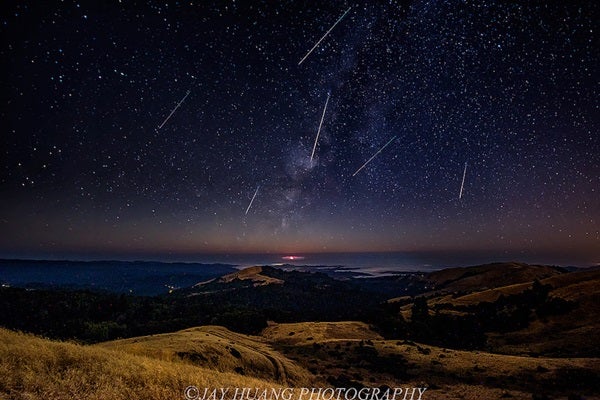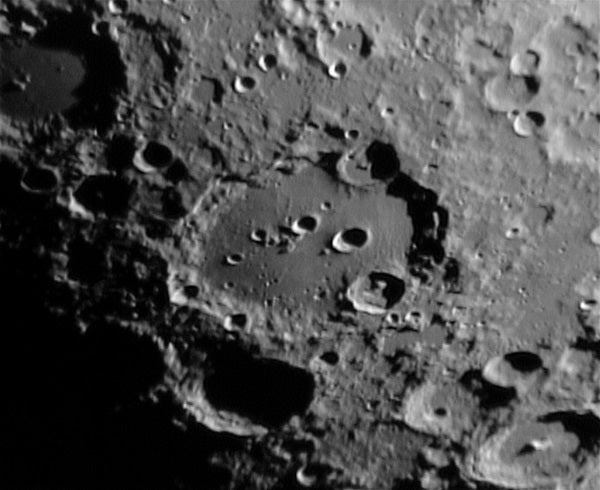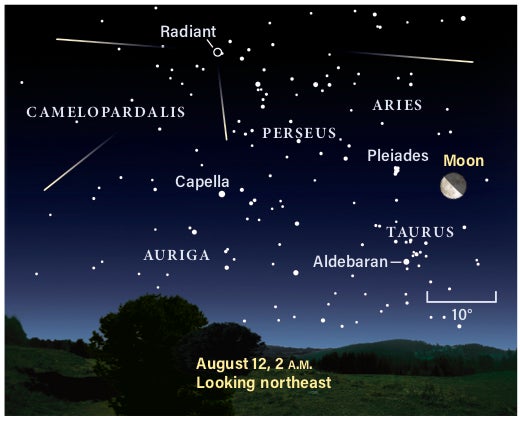For a few hours after sunset, Scorpius the Scorpion is visible in the southern sky. It should be easy to pick out his golden magnitude 1 heart, Antares, so named because it is easy to mistake the bright star for Mars. The star’s apparent brightness, even at its distance of 550 light-years, means it’s extremely luminous — about 10,000 times brighter than the Sun. With a mass at least 10 times that of the Sun, it will someday explode in a supernova, certainly visible from Earth.
If you have binoculars or a small telescope, shift your gaze less than 1.5° west of the star to find M4 (NGC 6121), a magnitude 5.4 globular cluster just over 26′ across. A group of more than 100,000 old stars, M4 often appears as a faint, wispy ball like a puff of cotton. Larger binoculars or telescopes should pick out some of the cluster’s outer stars, although the center, packed with so many glowing suns, may still appear nebulous.
Sunrise*: 6:04 A.M.
Sunset: 8:06 P.M.
Moonrise: 10:33 P.M.
Moonset: 9:50 A.M.
Moon Phase: Waning gibbous (84%)
*Times for sunrise, sunset, moonrise, and moonset are given in local time from 40° N 90° W. The Moon’s illumination is given at 12 P.M. local time from the same location.
Main belt asteroid 7 Iris is headed toward a hairpin turn next week against the background stars of Sagittarius. It’s located less than 1.5° southwest of M23 (NGC 6494), a young open star cluster discovered in 1764. The best time to find the faint magnitude 9.8 point of light is between sunset and moonrise; wait until the sky is as dark as possible, which will aid in your search.
Over the next several days, try returning to this region with your telescope to photograph or sketch Iris’ position each night. You should see the asteroid track westward day by day, approaching a magnitude 9.5 star that marks its turnaround point. It will swing around the star next Saturday, quickly starting to move east again after that.
Sunrise: 6:05 A.M.
Sunset: 8:05 P.M.
Moonrise: 10:56 P.M.
Moonset: 10:48 A.M.
Moon Phase: Waning gibbous (77%)
Sunday, August 9
The Moon passes 0.8° south of magnitude –1.2 Mars at 4 A.M. EDT. You can find the pair in Pisces the Fish, nearly 45° above the southeastern horizon this morning. At this time, the waning Moon is still 71 percent lit, while Mars is 87 percent lit and 16″ across. Although Pisces is devoid of relatively bright stars, look east of the Moon-Mars pair to find Menkar, Cetus’ alpha star, shining at magnitude 2.5. The star’s Arabic name means “the nose” or “nostrils,” although it’s often drawn as the mouth of the great celestial whale. This cool, red giant is a variable star in the last phases of its life; its light varies by up to 6 percent at irregular intervals. Astronomers believe Menkar once had about three times the mass of our Sun, but that it will ultimately lose most of that mass as it puffs away its outer layers in death.
The Moon reaches apogee at 9:50 A.M. EDT. At that time, our satellite will be 251,444 miles (404,659 kilometers) from Earth. This is the farthest point from our planet in the Moon’s slightly elliptical orbit; it will reach perigee, the nearest point to Earth, on the morning of the 21st.
Sunrise: 6:06 A.M.
Sunset: 8:04 P.M.
Moonrise: 11:21 P.M.
Moonset: 11:46 A.M.
Moon Phase: Waning gibbous (69%)
Monday, August 10
Today is 30th anniversary of the Magellan radar mapper’s arrival at Venus. Magellan was a keystone mission in our understanding of Earth’s sister planet, mapping 98 percent of the venusian surface down to features smaller than 328 feet (100 meters).
You can find Venus in the east this morning, rising higher in the three hours before sunrise. It glows a stunning magnitude –4.5 and appears 24″ across. Its disk is nearly 50 percent lit. The planet is located in the northeastern corner of Orion, between Taurus (above it) and Gemini (below) on the sky. The Hunter’s familiar figure stretches southwest of the planet. In addition to the familiar three stars of Orion’s Belt, look for golden-hued Betelgeuse and bright, blue Rigel, the figure’s right shoulder and left knee, respectively. They’ll be easier to spot as the constellation rises higher in the slowly brightening dawn.
The Moon passes 4° south of Uranus at 5 P.M. EDT. Like Venus, the ice giant is also a morning object; two hours before sunrise, you’ll find it high in the east, glowing at magnitude 5.8 in the constellation Aries. At that time, the Moon is about 8° southwest of the planet and located in Cetus the Whale. Given the bright Moon, finding our seventh planet may be a bit of a challenge in binoculars or a small scope. It’s a mere 4″ across and should appear as a dim, “flat” star with a soft gray color. Although the Moon will stay in this region of the sky for several days, it will continue to wane and dim, so you may want to revisit Uranus in a few days to see if it’s easier to locate with less background light.
Sunrise: 6:07 A.M.
Sunset: 8:02 P.M.
Moonrise: 11:46 P.M.
Moonset: 12:44 P.M.
Moon Phase: Waning gibbous (60%)

Would you like to learn more about Venus? Check out our free downloadable eBook: Venus and Mercury: Hot, volatile planets to explore the closest planets to the Sun.
Last Quarter Moon occurs at 12:45 P.M. EDT. Just like First Quarter Moon, now is a great time to look at features along the terminator dividing night from day on our satellite. In this case, however, the early morning hours are the best time to observe the Moon, as it rises before midnight and sets this afternoon, then won’t rise again until after midnight on the 12th.
For Northern Hemisphere observers, some of the best features visible through binoculars or a small scope during this lunar phase are the dark, smooth Mare Imbrium and Mare Nubium; the bright, rayed crater Copernicus, and the sweeping line of the Apennine Mountains. Other large craters you may spot include Plato, Ptolemaeus, Alphonsus, and Arzachel. In the rugged lunar south, Clavius may stand out as a large crater with several smaller craterlets creating a swooping curve within it.
Sunrise: 6:08 A.M.
Sunset: 8:01 P.M.
Moonrise: —
Moonset: 1:44 P.M.
Moon Phase: Last Quarter (50%)
The well-known Perseid meteor shower peaks this morning with a maximum rate of 100 meteors per hour. These spectacular meteors come from the trail of debris left by Comet 109P/Swift-Tuttle, which orbits the Sun every 133 years.
The shower’s radiant is high in the northeast around 2 A.M. local time. With the relatively bright Last Quarter Moon nearby in Taurus, you will likely see rates much lower than the expected maximum. But that doesn’t mean it’s not worth taking an early-morning stroll outside — the Perseids streak into our atmosphere at nearly 40 miles per second and bright meteors often leave behind long, glowing persistent trains.
Venus reaches greatest western elongation (46°) at 8 P.M. EDT. The planet remains an early morning object, however, so the best time to view it is in the hour or two before sunrise.
Sunrise: 6:09 A.M.
Sunset: 8:00 P.M.
Moonrise: 12:15 A.M.
Moonset: 2:44 P.M.
Moon Phase: Waning crescent (40%)
Thursday, August 13
Tonight is a great night to check out two famous circumpolar constellations: Ursa Major the Great Bear and Cassiopeia the Queen. These familiar celestial sights are situated on opposite sides of North Celestial Pole, so during the night they appear to swing around Polaris, the North Star. From higher latitudes they never appear to set, always visible above the horizon.
An hour after sunset, you can find the two constellations at roughly the same height above the northern horizon. The most recognizable part of Ursa Major is the Big Dipper asterism, which at this time appears on its side with its handle sticking straight up. In reality, the Big Dipper is only a small portion of the Great Bear, representing her stretched-out tail and hindquarters. Across the North Celestial Pole is Cassiopeia, whose equally recognizable W shape is tilted at about a 45° angle to the horizon. As the hours tick by, you’ll see the Big Dipper swing low, its cup tilting upward, while Cassiopeia swings higher. She first tips onto her side and ends the night upside-down as dawn on the 14th streaks the sky with light.
Sunrise: 6:10 A.M.
Sunset: 7:59 P.M.
Moonrise: 12:48 A.M.
Moonset: 3:45 P.M.
Moon Phase: Waning crescent (31%)
Friday, August 14
As darkness falls following sunset, swing your scope to Jupiter, hanging above the southeastern horizon in the constellation Sagittarius. The planet shines at magnitude –2.7 and should be easy to spot, with magnitude 0.2 Saturn just 8° to its east. Both will stay in the south all night, setting in the southwest in the early morning hours before sunrise on the 15th.
By dusk, Jupiter’s largest moon, Ganymede, is in the middle of a trek across the face of the planet, finally slipping off the disk at 10:51 P.M. EDT. Following the moon is its dark shadow, which slips onto the planet just before Ganymede exits and takes about three hours to cross. At 11:24 P.M. EDT, Io slides in front of Jupiter’s eastern limb; the smaller moon is much closer to the planet and its shadow follows just 44 minutes later, when Ganymede’s shadow is merely halfway across.
If you happen to miss the moons’ trek across Jupiter, don’t worry — you’ll have another chance later this month to watch them take a similar journey overnight on August 21/22.
Sunrise: 6:11 A.M.
Sunset: 7:57 P.M.
Moonrise: 1:28 A.M.
Moonset: 4:46 P.M.
Moon Phase: Waning crescent (22%)

Our exclusive Sky Guide 2020 is now available! This free downloadable pamphlet contains a month-by-month rundown of 2020’s biggest celestial events, from Mars’ best opposition in years to the return of totality in South America this December. Check out Astronomy’s Sky Guide 2020 now!












